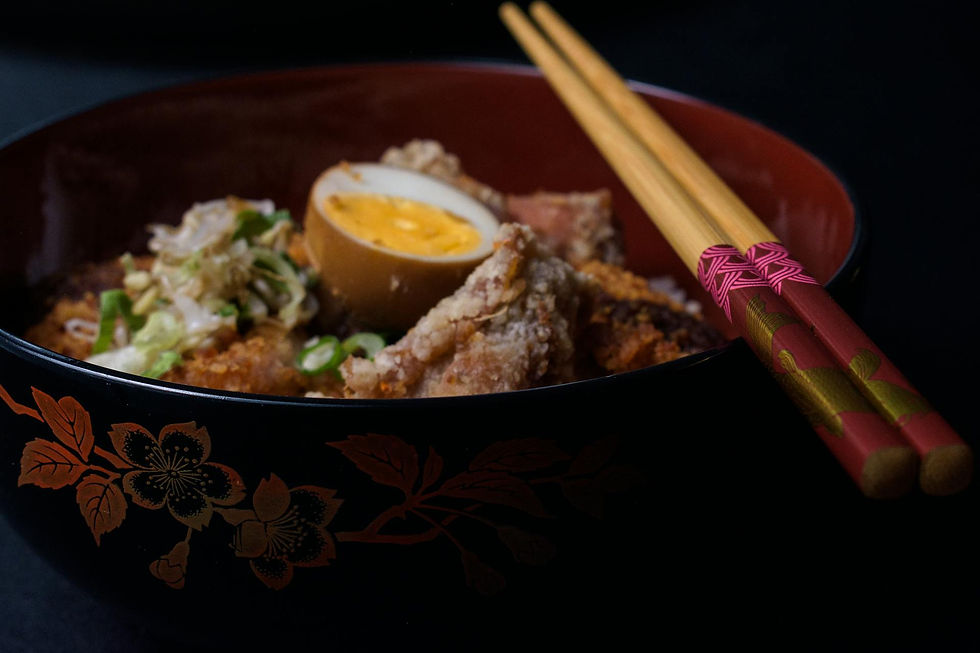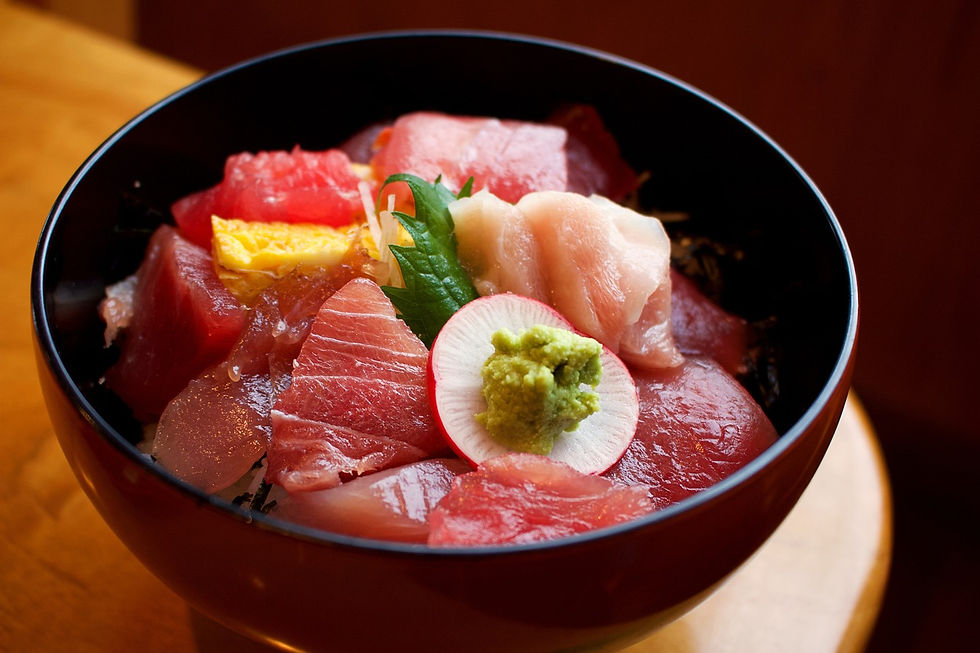What is Donburi
- Takashi Otsuka
- Jul 23
- 9 min read
Understanding Donburi
A Bowl That Represents Japanese Comfort Food
Donburi is a beloved dish found on menus across Japanese restaurants worldwide. While the word "donburi" simply means "bowl" in Japanese, it refers to much more than the vessel it’s served in. It’s a complete meal that captures the essence of Japanese comfort food: warm, balanced, and deeply satisfying.
Imagine a steaming bowl of perfectly cooked rice topped with savory ingredients like thinly sliced beef, golden fried cutlets, fresh seafood, or seasoned vegetables — all tied together with a rich, umami-packed sauce. That’s donburi in its purest form.
The Simplicity and Flexibility of Donburi
One of the most special things about donburi is its simplicity and adaptability. It’s the Japanese equivalent of a one-pot meal — a dish where everything you need is neatly layered into one bowl.
Quick to prepare
Easy to customize
Perfect for lunch or dinner
Great for home cooks and chefs alike
Whether you're craving something hearty or light, there’s a donburi to suit your taste.
A Balanced and Nutritious Meal
Most donburi dishes are nutritionally well-balanced, typically offering:
A base of carbohydrates (rice)
A source of protein (meat, fish, tofu, or egg)
Complementary vegetables or garnishes
A flavorful sauce that unites all the components
This makes donburi not only filling, but also wholesome — a go-to comfort meal that doesn't feel heavy.
Types of Donburi You’ll Love
The variety of donburi is what makes it truly exciting. Here are some classic options to explore:
Donburi Type | Description |
Gyudon | Thinly sliced beef and onions simmered in a slightly sweet soy-based sauce |
Katsudon | Crispy breaded pork cutlet with egg, simmered in broth over rice |
Oyakodon | Chicken and egg cooked in dashi-soy sauce, known as the “parent-and-child” bowl |
Kaisendon | A fresh sashimi-style bowl with assorted raw seafood |
Tendon | Tempura (shrimp or vegetables) served over rice with sweet soy glaze |
Each bowl offers a different flavor experience — from bold and rich to light and refreshing.
The Secret Is in the Sauce
While the toppings vary, donburi always comes alive through the sauce. Most sauces are soy-based, often mixed with ingredients like:
Mirin (a sweet rice wine)
Sake
Dashi (a savory Japanese broth)
These components create layers of flavor that soak into the rice and toppings, uniting the dish in every bite.
A Reflection of Japanese Culinary Culture
Donburi has humble beginnings as street food and quick meals for workers, but it has grown into a staple of Japanese cuisine. Today, it’s enjoyed in everything from fast-casual restaurants to refined bento shops — and remains just as loved in Japanese homes.
Its enduring popularity lies in its:
Simplicity
Flexibility
Deep-rooted cultural history
Universal appeal
Whether served at home or in a restaurant, donburi offers a taste of Japan’s culinary heart.
Frequently Asked Questions About Donburi
What does “donburi” mean?
"Donburi" literally means "bowl" in Japanese, but in food terms, it refers to a rice bowl dish topped with various savory ingredients.
Is donburi always served hot?
Most donburi bowls are served hot, but some — like kaisendon (sashimi bowls) — are served cold with fresh, raw seafood.
Is donburi healthy?
Yes, donburi can be a balanced meal with protein, carbs, and vegetables. Healthiness depends on the ingredients and preparation style.
Can vegetarians enjoy donburi?
Absolutely. Many variations use tofu, egg, or vegetables as toppings. Sauces can be adjusted to be plant-based.
How is donburi different from poke bowls?
While both are rice bowls, donburi is rooted in Japanese cuisine with ingredients like tempura, simmered meats, or raw fish served with soy-based sauces. Poke bowls originate from Hawaii and typically feature marinated raw fish with tropical or fusion toppings.

Defining Features of Donburi
A Perfect Balance in One Bowl
Donburi is a quintessential example of Japanese culinary simplicity and balance. Each bowl brings together essential nutrients — protein, carbohydrates, and rich flavor — all layered over a bed of steamed rice. It’s this thoughtful composition that makes donburi not just filling, but also nutritionally complete.
Adaptable to Any Craving
One of donburi’s most loved features is its versatility. Whether you’re craving something warm and savory like gyudon, or something light and refreshing like kaisendon, there’s a donburi for every appetite.
Craving | Try This Donburi | Flavor Profile |
Hearty & savory | Gyudon | Beef + onions in sweet soy |
Crispy comfort | Katsudon or Tendon | Crunchy pork or tempura with sauce |
Light & fresh | Kaisendon | Raw seafood, chilled, delicate |
Homey & soft | Oyakodon | Chicken and egg in light broth |
This adaptability makes donburi a reliable choice for both everyday meals and special occasions.
A Symphony of Textures
Texture is a key element of donburi’s appeal. The soft, fluffy rice provides a neutral base, while the toppings bring contrast:
Tendon: Crunchy tempura adds crispness
Oyakodon: Silky egg and tender chicken create a smooth, comforting texture
Katsudon: Crispy pork cutlet softens in savory sauce for a balanced bite
Each combination delivers a layered eating experience that keeps every spoonful interesting.
Sauce as the Unifying Element
What truly ties a donburi together is the sauce. Typically soy-based, it’s often infused with:
Mirin (sweet rice wine)
Dashi (umami-rich broth)
Sometimes sake or sugar, depending on the regional style
The sauce is more than just seasoning — it brings depth, harmony, and consistency to the entire bowl. Every bite becomes cohesive, rich, and satisfying.
The Art of Presentation
Japanese cuisine values not just taste, but also visual harmony — and donburi is no exception. The careful placement of ingredients over white rice isn’t just aesthetic, it’s purposeful:
Balanced color combinations
Clean, intentional arrangement
A visual representation of simplicity and mindfulness
This thoughtful presentation adds to the enjoyment before the first bite is even taken.
Simple to Make, Hard to Forget
Despite how polished and complete donburi looks, it’s surprisingly easy to make at home. The structure is simple: rice + toppings + sauce. Yet it delivers a deeply satisfying meal that checks all the boxes — taste, nutrition, texture, and comfort.
That’s why donburi continues to be a staple in Japanese home kitchens and an enduring favorite in restaurants.
Frequently Asked Questions About Donburi Features
What makes donburi unique compared to other rice bowls?
Donburi isn’t just rice with toppings — it's a thoughtfully balanced meal where sauce, texture, and flavor work together in harmony.
Is sauce always included in donburi?
Yes, a soy-based sauce is typically used to tie the ingredients together and infuse the rice with flavor.
Are donburi dishes spicy?
Most traditional donburi dishes are not spicy. However, spicy variations can be made depending on preference.
Is donburi meant to be mixed before eating?
It’s usually eaten as-is, enjoying the layers of texture. Some people gently mix the sauce through the rice, but full mixing is not traditional.
Can I make donburi at home without special ingredients?
Yes! Basic soy sauce, rice, onions, eggs, and your protein of choice are enough to make a simple donburi dish at home.

The Historical Context of Donburi
Donburi’s Origins in Edo Period Japan
The story of donburi begins in the vibrant streets of Edo-period Japan (1603–1868), where it emerged as a practical street food for everyday people. As Japan’s urban centers expanded and more workers crowded into the cities, there was a growing demand for meals that were quick, hearty, and portable.
Donburi answered that need perfectly — a simple bowl of rice topped with flavorful ingredients that could be made quickly and eaten on the go.
Street Food for the Working Class
Street vendors were a common sight during the Edo period. Many specialized in creating affordable rice bowl meals that offered nutrition and flavor with minimal fuss. The idea of topping rice with simmered meats, vegetables, or fish became a fast favorite among workers, travelers, and lower-income families.
This simple yet satisfying concept made donburi not just a dish of convenience, but a beloved part of daily life.
Timeline – Donburi Through the Ages
Period | Key Developments |
Edo Period (1603–1868) | Donburi emerges as street food; quick, filling, and cheap |
Meiji Era (1868–1912) | Western influences introduce new ingredients and preparation styles |
Taisho–Showa Era | Donburi gains popularity in homes; new varieties emerge regionally |
Modern Day | A staple in Japanese restaurants and homes; now globally recognized |
Regional Variations Take Root
As donburi spread across Japan, local regions added their own twist based on available ingredients and cooking traditions:
Coastal areas developed seafood-based donburi like kaisendon
Inland regions focused on meat-forward bowls like gyudon and oyakodon
Rural areas often used seasonal vegetables and wild mountain herbs
This regional diversity helped shape the rich catalog of donburi dishes enjoyed today.
Donburi in Social and Communal Dining
The Edo period also brought a shift in how meals were experienced. Communal dining became more common, with restaurants and teahouses serving groups. Donburi, being easy to make and serve in large quantities, naturally found its place on communal tables.
It became a social food — something people could enjoy together — and helped solidify its cultural significance as more than just a fast meal.
Adapting Through the Eras
When Japan entered the Meiji era, new global influences brought ingredients like Worcestershire sauce, breaded pork (used in katsudon), and Western cooking techniques. But instead of being replaced, donburi evolved. Its flexibility allowed it to absorb these changes and remain relevant through every generation.
Today, donburi is just as beloved — now seen in everything from casual chains to fine-dining kaiseki interpretations, both in Japan and internationally.
A Dish That Has Stood the Test of Time
From a humble street snack to a cultural icon, donburi’s evolution reflects the values at the heart of Japanese cuisine: balance, adaptability, and flavor.
Its continued popularity comes from:
Convenience — a full meal in one bowl
Tradition — rooted in history, passed down generations
Creativity — open to new ingredients, techniques, and interpretations
Whether you’re grabbing a quick bite or sitting down for comfort food, donburi remains a symbol of everyday satisfaction.
Frequently Asked Questions About Donburi’s History
When was donburi first invented?
Donburi originated during the Edo period (1603–1868) as a fast, hearty street food for workers and travelers.
Why did donburi become so popular in Japan?
Its simplicity, balance of nutrition, and quick preparation made it ideal for busy urban life. It was affordable, tasty, and filling.
How did donburi evolve over time?
Over the centuries, donburi adapted to regional flavors, absorbed Western ingredients during the Meiji era, and grew from street food into a national comfort dish.
Is donburi still considered street food?
Not anymore — while it has humble origins, donburi is now widely served in restaurants and home kitchens across Japan and the world.
What makes donburi culturally significant?
It reflects core values of Japanese cuisine: harmony, efficiency, and the ability to turn simple ingredients into something meaningful and delicious.

Popular Types of Donburi
One Dish, Endless Possibilities
One of the best things about donburi is its incredible variety. From rich and hearty to light and fresh, each version of this rice bowl dish brings its own unique flavor, texture, and personality. Whether you’re a meat lover, seafood enthusiast, or just in the mood for something comforting, there’s a donburi for you.
Quick Overview – Popular Donburi Types
Donburi Type | Key Ingredients | Flavor Profile |
Gyudon | Beef, onions, sweet soy sauce | Savory, slightly sweet, comforting |
Katsudon | Fried pork cutlet, egg, broth | Rich, crispy, creamy |
Oyakodon | Chicken, egg, dashi-based broth | Mild, warm, homey |
Tendon | Tempura (shrimp/veggies), soy glaze | Crunchy, light soy sweetness |
Unadon | Grilled eel, sweet soy glaze | Smoky, sweet, elegant |
Kaisendon | Assorted sashimi over rice | Fresh, delicate, slightly chilled |
Gyudon – The Beef Lover’s Favorite
Gyudon is a classic donburi made with thinly sliced beef and onions simmered in a sweet-savory soy-based sauce. The beef becomes incredibly tender and flavorful, while the onions add a gentle sweetness that balances the richness. It’s satisfying, budget-friendly, and a go-to comfort food across Japan.
Katsudon – Crispy Meets Creamy
Katsudon starts with a breaded pork cutlet (tonkatsu), fried until golden and crispy. It’s then simmered in broth with beaten eggs, creating a soft, savory topping that melts into the rice. The contrast of crunchy pork and fluffy egg makes katsudon a deeply satisfying dish — perfect for a filling lunch or dinner.
Oyakodon – The Parent-and-Child Bowl
The name oyakodon comes from the Japanese words oya (parent) and ko (child), referencing its combo of chicken and egg. Both are gently simmered in a soy-dashi broth, then poured over rice. It’s mild, comforting, and commonly eaten at home — a true taste of Japanese family cooking.
Tendon – A Tempura Lover’s Dream
Tendon brings the crispy magic of tempura to the donburi format. Shrimp, vegetables, or seasonal items are battered and deep-fried, then placed atop rice and lightly glazed with a sweet-savory soy sauce. The combination of textures — crispy topping, fluffy rice — makes tendon an exciting and flavorful meal.
Unadon – Grilled Eel with Sweet Glaze
Unadon is a more luxurious choice, featuring grilled eel (unagi) brushed with a sweet soy-based sauce (tare). The eel is cooked until tender and slightly smoky, with the sauce caramelizing as it grills. It’s bold, rich, and often seen as a treat during the summer months in Japan.
Kaisendon – The Sashimi Bowl
Kaisendon is a chilled, fresh donburi featuring a variety of raw seafood like tuna, salmon, shrimp, and roe arranged beautifully over a bowl of rice. A light soy-based dressing or wasabi-soy sauce is often served on the side. It’s a must-try for sashimi lovers who want something refreshing and clean.
Frequently Asked Questions About Donburi Types
What is the most popular donburi in Japan?
Gyudon is among the most widely eaten donburi, thanks to its affordability, flavor, and availability at fast-casual chains like Yoshinoya and Sukiya.
Which donburi is best for first-timers?
Katsudon or gyudon are great starting points — both are cooked, hearty, and widely enjoyed. For seafood fans, kaisendon offers a fresh introduction.
Is katsudon spicy?
No, katsudon is savory and rich, but not spicy. However, you can always add a pinch of shichimi togarashi (Japanese chili powder) if you want some heat.
What’s the difference between oyakodon and katsudon?
Oyakodon uses chicken and egg in a light broth, while katsudon uses deep-fried pork cutlet with egg in a richer sauce.
Can you find vegetarian donburi options?
Yes! Some donburi bowls feature tofu, mushrooms, or seasonal vegetables — especially in Buddhist temple cuisine or at modern Japanese cafes.




Comments